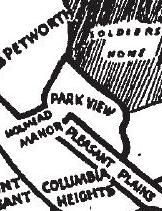As anyone who has lived in Park View for a while knows, we have a lot of hot, treeless streets due to a lack of planning when the neighborhood was originally building out. I have had numerous conversations over the years with neighbors who would like to see more trees, and have worked to get more spaces for street trees where ever I find an opportunity.
While out walking last week, it dawned on me that an ideal place to add more trees could be the 800 block of Princeton Place, NW. While it is a short street with only two rowhouses on it, I think every treebox we can create improves the entire neighborhood.
What makes the 800 block of Princeton Place promising for adding tree box bump outs is its width and configuration. Currently, it is designated as a one-way street (east bound). It also currently does not allow parking on either the north or south side of the street (although I have seen people park on the south side on more than one occasion). The street is also just over 35 feet wide, meaning that is is over built for the two lanes of traffic it allows.

Measurment in ArcGIS indicates that Princeton Place is 35 feet wide, more than enough for two lanes of traffic and tree box bump outs.
An onsite visit to the street along with reviewing maps indicates that there may be utility infrastructure on the south side of the street, so that leaves the north side open to potential reconfiguration — which is actually better as southbound New Hampshire buses turn onto Princeton Place to travel north on Georgia Avenue.
Below is a rough outline of where curb bump outs could occur on the north side of the street. Depending upon tree selection and planting location, this should create room for 4 to 6 new trees.

Bump outs on Princeton Place could create room for 4-6 new trees, depending upon tree selection and planting location.
While cost is always a factor, when I mentioned this opportunity to some folks at DDOT during a recent meeting, there was some excitement about this. Narrowing the street would improve vehicular safety, narrowing the crossway at Georgia would improve pedestrian safety, and the new trees would increase the overall tree canopy — all DDOT goals.
So what are your thoughts, shall we make this a priority in 2020?



















 "The territory comprising Park View extends from Gresham Street north to Rock Creek Church Road, and from Georgia Avenue to the Soldiers' Home grounds, including the triangle bounded by Park Road, Georgia Avenue, and New Hampshire Avenue" (from Directory and History of Park View, 1921.)
"The territory comprising Park View extends from Gresham Street north to Rock Creek Church Road, and from Georgia Avenue to the Soldiers' Home grounds, including the triangle bounded by Park Road, Georgia Avenue, and New Hampshire Avenue" (from Directory and History of Park View, 1921.)
